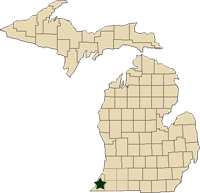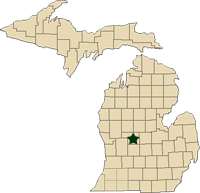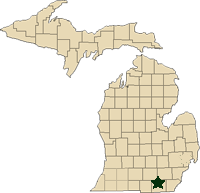Regional reports on Michigan vegetables – June 27, 2012
MSU Extension educators’ pest and vegetable updates for Michigan.
This week’s regional reports:
- Southwest Michigan – Ron Goldy
- Central Michigan – Fred Springborn
- Southeast Michigan – Lina Rodriguez Salamanca
Southwest Michigan – Ron Goldy, Michigan State University Extension
|
Weather
Temperatures for the week were near normal with highs from 76 to 92°F and lows from 52 to 71°F. There was no precipitation in the region. At the Southwest Michigan Research and Education Center, we have only had 0.55 inches of rain since June 1. Conditions continue extremely dry with non-irrigated fields showing significant stress.
Crop reports
Sweet corn has responded to the increased temperatures as long as the field is irrigated. Growers using row covers will be harvesting soon. Non-row covered fields are at tassel emergence. No reports of Stewart’s wilt at this time, which is surprising given our mild winter.
Pepper transplanting continues as does staking and tying. Early planted peppers have 2-inch diameter fruit.
Harvest of cucumbers, summer squash and zucchini continues from tunnel-grown fields. Transplanted fall squash is sizing fruit well. Direct seeding continues. Squash vine borers were caught for the first time this week, so growers should be applying protective sprays. Some growers have reported problems with fruit and flower abortion. This is most likely due to the high temperatures reducing bee pollinating activity and reducing the amount of time the flowers are receptive.
Watermelon and cantaloupe transplants are runnering off the plastic, flowering and setting fruit.
Tomato staking, pruning and tying continues. Bacterial problems have been identified on tunnel-grown plants. Growers should be diligent in applying protective copper products. The dry weather should help minimize the spread of the disease. Fruit on early, tunnel-grown plants continues to size well. Fruit on non-protected, early plantings is 2 inches in diameter.
Central Michigan – Fred Springborn, Michigan State University Extension
|
Weather
No rain in the past week. High air temperatures ranged from the upper 70s to the mid-80s. Low air temperatures were in the upper 40s to low 60s. Humidity levels have been quite low.
Crops
Dry bean planting is mostly complete. Germination and emergence has been rapid in most cases; many fields have their first trifoliate leaves. There are a few recently planted fields that are lacking sufficient moisture to germinate.
Pea harvest has begun
Most potato fields are setting tubers; in the fields I have looked at set appears to be good to very good. There are no reports of late blight in Michigan. Preventative applications of fungicides are continuing in potatoes. Reports from eastern states of late blight on tomatoes and potatoes are still surfacing, the majority of the late blight reports in Pennsylvania have been the US-23, mefenoxam (Ridomil) sensitive, genotype. Potato leafhoppers are present in low numbers. Variegated cutworm is being found in low numbers.
We continue to catch low numbers of western bean cutworm moths in pheromone traps.
Southeast Michigan – Lina Rodriguez Salamanca, Michigan State University Extension
|
Weather
Dry soil is the common denominator in our area. Irrigation on fields continues, but non-irrigated crops, such as peppers and tomatoes, seem to be growing slowly. We had only one rain event on June 21 in Lenawee, Washtenaw and Wayne counties, with a total of 0.34 inches of rain. Temperatures remain high, ranging from 94.4 to 53.6°F (in the early morning).
Crops pests
Spotted and striped cucumber beetles are active in cucurbit crops. Two squash vine borer moths were found in the Washtenaw County trap, while the trap in Monroe County did not have any squash vine borers. Vines are establishes and cucurbit fruit harvest continues.
In the Monroe County spore trap, cucurbit downy mildew counts increased during June 16-18. No cucurbit downy mildew has been confirmed in Michigan.
Later cabbage plantings have diamond back moth larvae and imported cabbage worms. Cabbage downy mildew has not been observed in the field. The hot and weather is not conducive to this disease. Cabbage harvest continues.
Sweet corn fields are on stages V10, Vt and R1. A corn earworm moth was caught in each of the southeast Michigan traps (Monroe-Washtenaw). Monitoring will continue. The risk of corn rootworm is currently high in our area (according to www.insectforecast.com); this is especially important for farmers growing non-BT corn.
In southeast Michigan, the risk for western bean cutworms is moderate. Counts of western bean cutworms have been reported in south central Michigan on field corn. Monitoring will start shortly in sweet corn.
Leafhoppers were observed on a carrot field. The carrot foliage had initial symptoms of aster yellows. Leafhoppers infectivity was 12 percent; this is the same level in Ottawa County (see Update on aster leafhopper infectivity in Michigan for June 13-19, 2012). The threshold for this level is three to four leafhoppers per 100 sweeps. Insecticide application is recommended when threshold has been reached.
Colorado potato beetle adults and larvae are abundant on potato fields. Leafhoppers are causing foliar damage on some fields.
Degree-day (DD) models and pest status (according to the Petersburg Enviro-weather station)
|
Crops |
Pest |
DD Status 6/21/12 |
Comments |
Recommended |
|
Potato and other vegetables |
Variegated cutworm |
DD 1591 |
First generation eggs and larvae present |
Inspect fields for damage caused by larvae |
|
Cucurbits, sweet corn, snap beans, |
Seed corn maggot |
DD 2163 |
First generation flight complete |
|
|
Cole crops |
Cabbage maggot |
DD 1774 |
Peak adult flight of first generation completed. Some flies may still be laying eggs. |
|
|
Cucurbits |
Squash vine borer |
DD 1022 |
Squash vine borer moths flying and laying eggs. |
Scout fields for eggs and damage |



 Print
Print Email
Email




